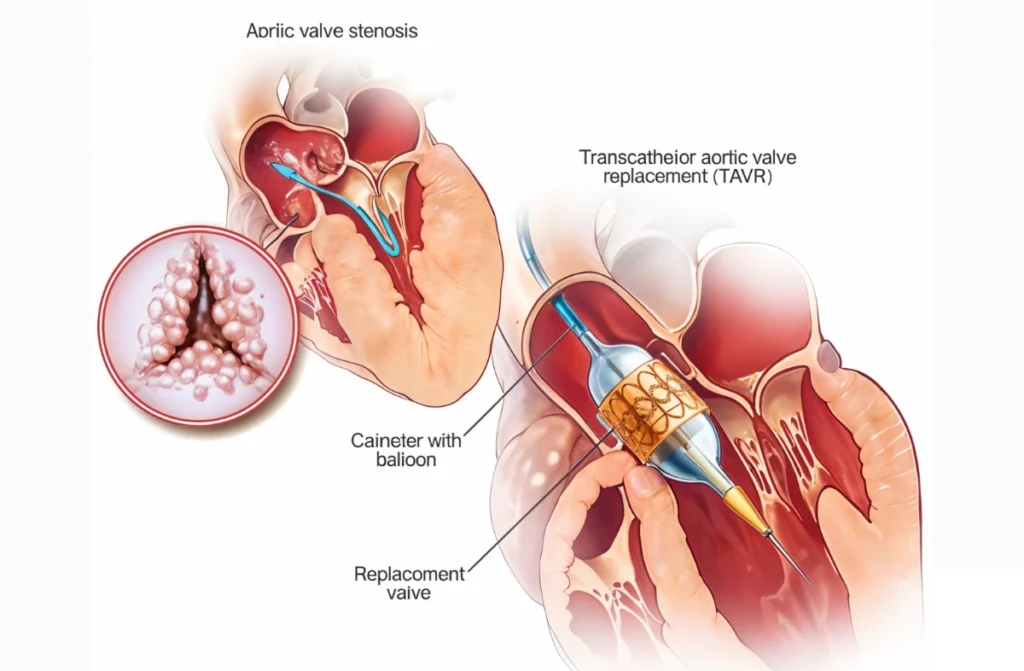Transcatheter Aortic Valve Replacement (TAVR) or Transcatheter Aortic Valve Implantation (TAVI), is a minimally invasive procedure that is used to treat severe aortic valve stenosis. Transcatheter Aortic Valve Replacement in Chennai offers an alternative to traditional open-heart surgery for patients who are considered high-risk or ineligible for surgery. This page provides an overview of Transcatheter Aortic Valve Implantation in Chennai including the TAVR procedure, benefits, risks, and recovery.
What is Transcatheter Aortic Valve Replacement?
Transcatheter Aortic Valve Replacement (TAVR) is a minimally invasive procedure used to treat aortic valve stenosis, a condition where the aortic valve in the heart narrows and causes restricted blood flow. TAVR involves replacing the damaged valve with a new one without requiring open-heart surgery. The procedure is typically recommended for patients who are not suitable candidates for traditional surgery due to their age or other health issues.
Key points:
- TAVR is a minimally invasive treatment option.
- It is used for patients with aortic valve stenosis.
- The procedure involves replacing the damaged valve without open-heart surgery.
- It is an alternative to open-heart surgery for high-risk patients.
- TAVR can improve symptoms like chest pain and shortness of breath.

What is Aortic Valve Stenosis?
Aortic valve stenosis refers to a medical condition where the aortic valve becomes narrowed, resulting in the obstruction of blood flow from the left ventricle of the heart to the aorta. It can lead to symptoms such as chest pain, shortness of breath, fatigue, and fainting. Severe aortic valve stenosis requires intervention to restore proper blood flow.
Transcatheter Aortic Valve Replacement in Chennai
TAVR/TAVI is a procedure that involves replacing the damaged aortic valve with an artificial valve through a catheter. Instead of a large incision and open-heart surgery, Transcatheter Aortic Valve Replacement in Chennai is performed using small incisions, which reduces the risks and recovery time associated with traditional surgery.
Transcatheter Aortic Valve Replacement (TAVR) is a minimally invasive procedure used to treat severe aortic valve stenosis. It is an alternative to traditional open-heart surgery, offering several benefits, especially for patients who are not suitable for surgery due to age or other health conditions.
Treatment procedure:
- Access: A catheter is inserted through a small incision, typically in the groin, to reach the heart.
- Valve placement: The new valve, usually made of biological material, is placed over the damaged valve and expanded using a balloon or a self-expanding mechanism.
- Outcome: The procedure restores normal blood flow, improving symptoms like shortness of breath, fatigue, and chest pain.
Key benefits of TAVR:
- Less invasive compared to traditional surgery.
- Shorter recovery time and hospital stay.
- Suitable for high-risk patients.
- Provides immediate symptom relief and improved quality of life.
This treatment has become a leading choice for aortic valve replacement in many patients.
TAVR Procedure
Before the TAVR Procedure:
- Diagnosis: The doctor conducts a series of tests, including echocardiograms, CT scans, and a physical examination, to evaluate the condition of the heart and the aortic valve.
- Preparation: Patients are asked to stop taking certain medications and may need to fast for several hours before the procedure.
- Anesthesia: General anesthesia or local sedation is used, depending on the patient’s condition.
During the TAVR Procedure:
- Accessing the Aortic Valve: The procedure is typically performed through a catheter inserted into a blood vessel, most commonly via the femoral artery in the groin.
- Valve Insertion: The catheter is guided to the aortic valve, where a balloon is inflated to make space for the new valve.
- Valve Deployment: A bioprosthetic valve is inserted and positioned, and the balloon is inflated to secure the valve in place.
- Monitoring: During the procedure, the patient’s vital signs and heart activity are closely monitored.
After the TAVR Procedure:
- Recovery Time: After the procedure, patients are typically monitored in the hospital for a few days. Most people can return home within 3-5 days.
- Follow-up: Regular follow-up appointments are necessary to ensure the new valve is functioning well and to monitor for any complications.
- Post-Procedure Care: Patients are advised to avoid heavy physical activity and follow a heart-healthy lifestyle.
Transcatheter Aortic Valve Replacement in Chennai is a widely recognized and effective option for treating severe aortic valve stenosis. The procedure offers numerous advantages, including shorter recovery time and a reduced risk for high-risk patients who are not suitable candidates for traditional surgery.
Benefits
TAVR/TAVI offers several advantages over traditional open-heart surgery:
- Minimally Invasive: Transcatheter Aortic Valve Implantation in Chennai requires smaller incisions compared to open-heart surgery, resulting in reduced trauma to the body, less pain, and faster recovery.
- Shorter Hospital Stay: The recovery period for TAVR/TAVI is typically shorter, allowing patients to leave the hospital sooner and return to their daily activities more quickly.
- Reduced Risk: Transcatheter Aortic Valve Replacement in Chennai is a viable option for patients who are considered high-risk or ineligible for open-heart surgery due to underlying health conditions.
These advantages make TAVR/TAVI a preferred option for many patients, offering a less invasive alternative with quicker recovery times and reduced complications.
Risks and Complications
While TAVR/TAVI is generally safe, there are potential risks and complications associated with the procedure:
- Bleeding: There may be bleeding at the incision site or internally during the procedure.
- Infection: Like all invasive procedures, there is a possibility of infection.
- Valve Malposition or Migration: The replacement valve may not be properly positioned or could migrate after deployment, requiring additional intervention.
- Vascular Complications: Damage to blood vessels during catheter insertion could lead to complications such as dissection or rupture.
- Stroke: In rare cases, a stroke may occur as a result of debris dislodging during the procedure.
These risks are generally low, especially when the procedure is performed by experienced specialists. If you are considering the TAVR procedure for treating aortic valve stenosis, it is essential to consult with a healthcare professional to discuss these potential risks and determine the most suitable treatment plan. Transcatheter Aortic Valve Replacement in Chennai has become a highly effective option for many patients, offering fewer complications than traditional open-heart surgery.
Recovery and Follow-Up
Following the Transcatheter Aortic Valve Replacement in Chennai procedure, patients are monitored in the hospital for a few days to ensure proper healing and to manage any complications. Once discharged, patients are advised to follow their healthcare provider’s instructions regarding medications, physical activity, and follow-up appointments. Regular follow-up visits are important to assess the functioning of the replacement valve and monitor the patient’s overall health. As for the cost of TAVR, it varies depending on the hospital and the specific case, but it is essential for patients to consider both the procedure cost and any associated post-operative care when planning for treatment.
Conclusion
Transcatheter Aortic Valve Implantation in Chennai is a minimally invasive procedure that offers an alternative treatment option for severe aortic valve stenosis. With its numerous benefits, including shorter recovery time, reduced risk, and eligibility for high-risk patients, TAVR/TAVI has become a valuable technique in the field of cardiology. As with any medical procedure, it is essential to consult with a healthcare professional to determine the most appropriate treatment plan based on individual circumstances. When considering treatment options, patients should also take into account the cost of TAVR, which can vary depending on the hospital and specific case, to ensure a well-informed decision.
Also, Read Heart Valve Replacement Surgery.


